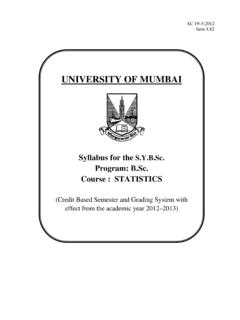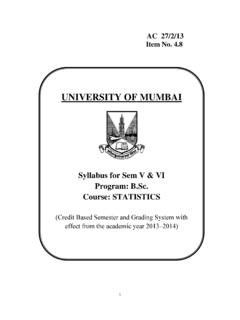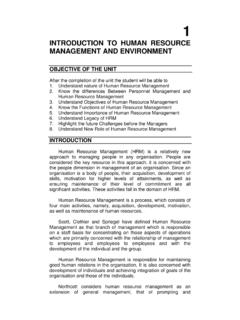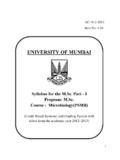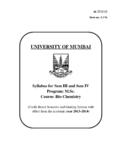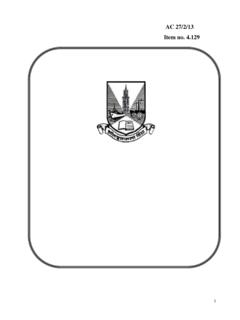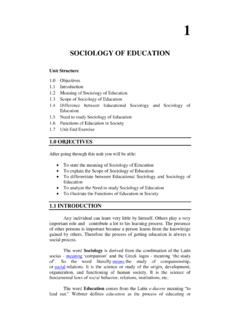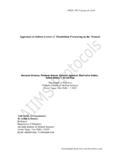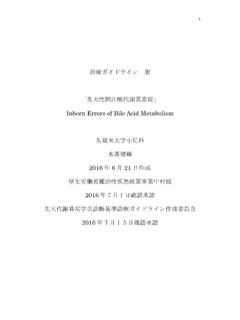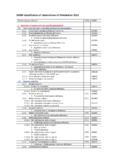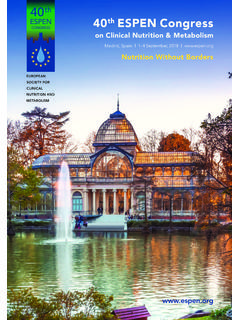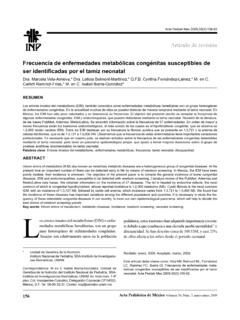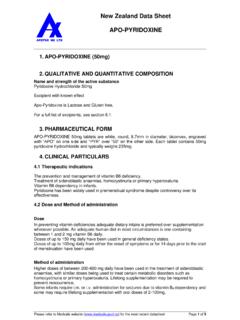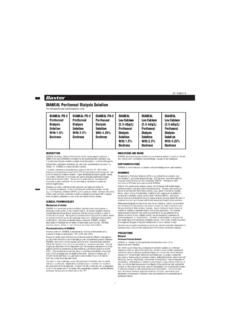Transcription of UNIVERSITY OF MUMBAI
1 1 AC 29/4/13 Item no. UNIVERSITY OF MUMBAI Syllabus for Semesters III and IV Program: Course: Life Sciences Specialisation: Biological Macromolecules (Credit Based Semester and Grading System with effect from the academic year 2013 2014) 2 Life Sciences Syllabus For Credit Based and Grading System To be implemented from the Academic year 2013 2014 SEMESTER III Course Code UNIT TOPIC HEADINGS Credits L / Week PSLSCBM301 I Biomathematics 4 II Research Methodology III Biostatistics IV Population Biostatistics PSLSCBM302 I Chemical Bonds and Spectroscopic Techniques 4 II Biomembrane III Cell Matrix IV Protein Trafficking and Targeting PSLSCBM303 I Bioenergetics and Carbohydrate metabolism 4 II Lipid metabolism III Electron Transport Chain and Oxidative Phosphorylation IV Metabolic Regulation and Metabolic Disorders PSLSCBM304 I Protein Structure and Folding 4 II Supramolecular Assemblies and DNA protein Interactions III Complex Proteins IV Protein
2 Engineering PSLSCBMP301 Biomathematics and Biostatistics 2 PSLSCBMP302 Bioanalytical Techniques & Cell Dynamics 2 PSLSCBMP303 metabolism & Biomolecular Structure 2 PSLSCBMP304 Dissertation on Literature Review 2 3 SEMESTER IV Course Code UNIT TOPIC HEADINGS Credits L / Week PSLSCBM401 I Bioinformatics I 4 II Bioinformatics II III Intellectual Property Rights IV Bioethics PSLSCBM402 I Cell Division and Apoptosis 4 II Programmed Cell Death and Cancer III RNAi and Epigenetics IV Cell Biology Techniques PSLSCBM403 I Amino Acid metabolism 4 II Nucleotide metabolism III Nitrogen Assimilation in Plants IV Photosynthesis and Secondary metabolism PSLSCBM404 I Structure of DNA and Replication 4 II Kinetics and Mechanism in Biological Systems III Methods in Proteomics and Genomics IV Nanobiology PSLSCBMP401 Bioinformatics 2 PSLSCBMP402 Molecular Cell Biology and metabolism 2 PSLSCBMP403 Biomolecular Function 2 PSLSCBMP404 Dissertation on Project 2 4 Life Sciences Syllabus Credit Based and Grading System To be implemented from the Academic year 2013 2014 SEMESTER III DETAILED SYLLABUS Course Code Title CreditsPSLSCBM301 Biomathematics / Research methodology / Biostatistics (60L) 4 Unit I.
3 Biomathematics (15L) Binomial Theorem (without infinite series) Determinants, Matrices, Rank of Matrices by Diagonalisation method Limit and derivatives, Differentiation (including differentiability), Successive Differentiation, Integration Definite and Indefinite (ordinary, method of substitution, special trigonometric function, partial fraction) Application of integration to find area, Differential equations homogeneous and Linear ODE s and its simple applications to biological problems Unit II: Research Methodology (15L) Meaning of Research; Objectives of research, motivation in research; Types of research Descriptive, Analytical, Applied, Fundamental, Quantitative, Qualitative, Conceptual, Empirical and Other Types of Research; Research Approaches; Research Methods vs.
4 Methodology; Research and Scientific Method; Research Process: Steps of research process; Criteria of Good Research; Sampling, Sample size determination, Plan for data collection, Methods of data collection, Plan for data processing and analysis; Ethical considerations during research Unit : III Biostatistics (15L) Basics: Introduction, scope, applications and uses of statistics, census and sampling surveys, Data, graphical presentation of data: collection and tabulation and graphical representation of data, frequency distribution Practice of statistical methods in biological research, Measures of central tendency (grouped and ungrouped data), samples and populations; Central tendency measures: Arithmetic mean, median, dispersion and its measures: variance and standard deviation, coefficient of variation.
5 Standard error, Confidence limits Skewness and kurtosis 5 Population parameters and sample statistics, sampling techniques: simple random sampling; stratified random sampling, systematic sampling, standard error estimation: point & interval, Estimators of population mean & proportion (without proof), confidence intervals for population mean & proportion. Regression and correlation and its application in biology; types of correlation, correlation coefficient Unit : IV Population Biostatistics (15L) Concept of probability, Theories of Probability additive and multiplicative theory Random variable and its distribution, Probability distributions Binomial, Poisson and Normal.
6 Tests of statistical significance, Testing of hypothesis: Hypothesis and its types (Null hypothesis, Alternative hypothesis), Errors and its types (Type 1 and Type 2 error), Levels of significance, one tailed and two tailed tests, tests for single mean and single proportion, equality of the two population means and two population proportions , Critical region. Difference between parametric and non parametric statistics; confidence interval, critical region, Levels of significance, t test; Z test; X2 test; Analysis of variance (ANOVA), one way ANOVA, Tukey s post hoc test, two way ANOVA Basic introduction to Muetrovariate statistics, etc. Bivariate data, scatter diagram and interpretation, calculation and interpretation of Karl Pearson s correlation coefficient, equation of the lines of regression and properties of regression lines 6 Practicals: PSLSCBMP301 Biomathematics and Biostatistics (60L) 1.
7 Mathematical sums to be solved in biomathematics and biostatistics 2. Formation of frequency distribution and calculation of descriptive measures mean, median, mode, variance, standard deviation and standard error 3. Large n small sample tests for sample mean and proportion 4. Calculation of correlation and regression, coefficients and tests of significance 5. ANOVA one way and two way classification; Estimation of genetic components and heritability from ANOVA data 2 04 Course Code Title CreditsPSLSCBM302 Bioanalytical Techniques and Cell Dynamics (60L) 4 Unit I: Chemical Bonds and Spectroscopic Techniques (15L) Inter atomic interactions, ionic, covalent and metallic bonds; Importance of weak, non covalent bonded interactions in biomolecules, such as van der Waals forces and hydrogen bonding; Energies and geometrics of these interactions and their roles in structure and conformation of biomolecules: Concept of pH, pKa and buffers Principle, methodology and applications of Fluorescence, Infrared, Raman, ESR, Atomic absorption spectroscopy.
8 Use of lasers for spectroscopy Optical Activity: Importance of chirality in biomolecules; Principles and applications of ORD and CD protein folding, folding intermediates, hierarchical and non heirarchical folding mechanisms. Unit II: Biomembrane (15L) Biomembranes: Structure and assembly; Orientation of membrane proteins, their solubilisation with detergents and enzymes; Membrane reconstitution; Liposomes and their application in biology and medicine Nuclear pore complex: Role in macromolecular exchange and regulation Unit : III Cell Matrix (15L) Molecules of the matrix: Proteins of the microfilament, microtubules and intermediary filaments; Structure, properties and assembly of actin and tubulin, examples and roles of these filaments in cell structure and function, eg.
9 , dynamics and roles of kinesin and dynein; Organization of proteins on microvillus 7 Extracellular Matrix: Structure; Cell cell/cell matrix interactions; Intracellular transport cilia and flagella Unit : IV Protein Trafficking and Targeting (15L) Intracellular Protein Trafficking and protein targeting; Secretory pathways in prokaryotes and eukaryotes; Signal sequences; Targeting of mitochondrial, chloroplast, peroxisomal and nuclear proteins; SNAPs and SNAREs Covalent modification of proteins: Phosphorylation, adenylation, methylation, ribosylation Practicals: PSLSCBMP302 Bionanalytical Techniques and Cell Dynamics (60L) 1. pka values ofAla or Gly by Titration Curve 2.
10 Determination of melting temperature (Tm) of DNA 3. Spectroflourimetric analysis of proteins 4. Preparation of lipid bilayer vesicles (liposomes) using the purified lipids 5. Effect of detergents on membranes 6. Fractionation of cell organelles from animal/plant tissues and identification by marker enzymes 7. Estimation of inorganic phosphorus by Fiske and SubbaRao method 2 04 Course Code Title CreditsPSLSCBM303 Bioenergetics and metabolism (60L) 4 Unit I: Bioenergetics and Carbohydrate metabolism (15L) Bioenergetics: Concept of free energy, standard free energy, determination of G for a reaction; Relationship between equilibrium constant and standard free energy change, biological standard state & standard free energy change in coupled reactions; Biological oxidation reduction reactions; Redox potentials; Relation between standard reduction potentials & free energy change.


